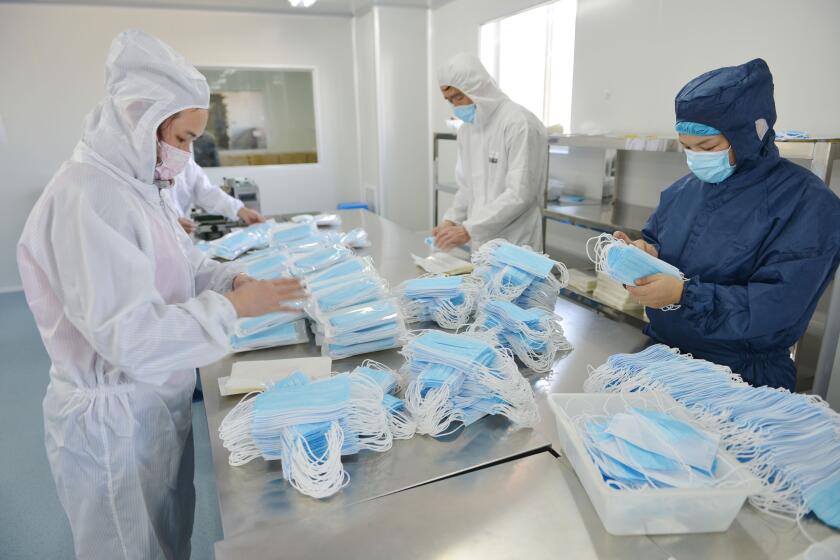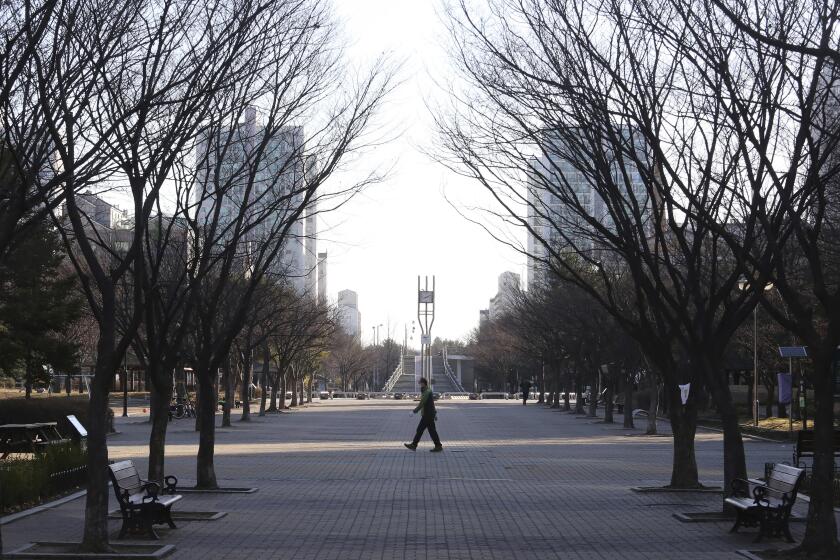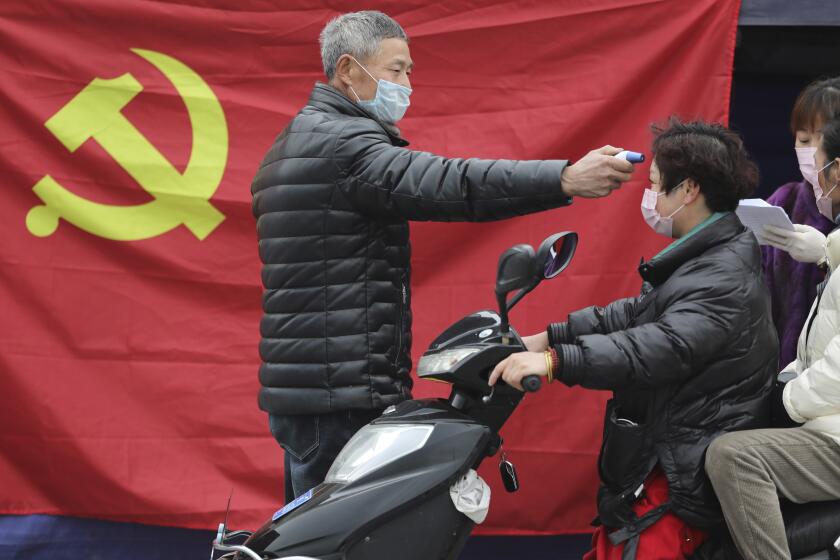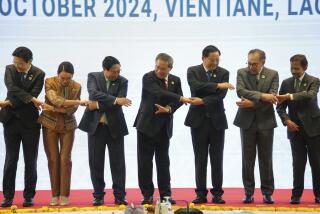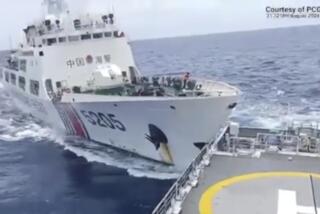What the coronavirus hasn’t stopped: Beijing’s buildup in the South China Sea
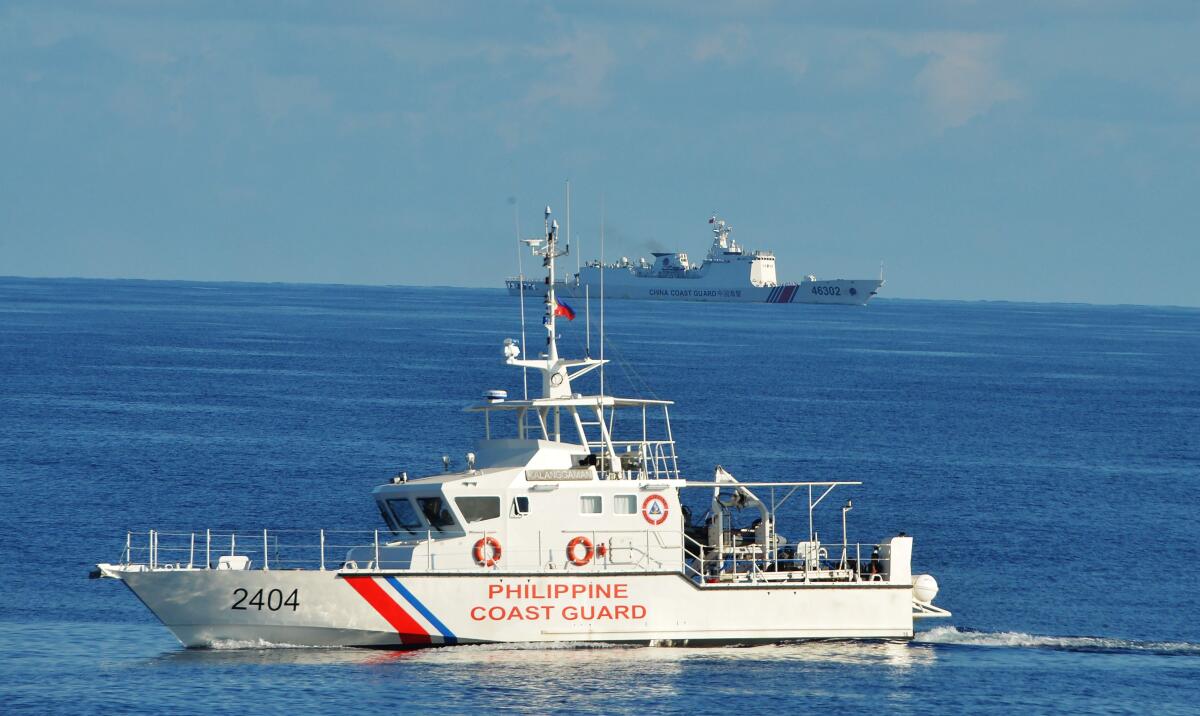
- Share via
SINGAPORE — Even as China’s President Xi Jinping mobilized a “people’s war” against the coronavirus, Chinese warships were busy on another front: maintaining their pressure campaign in the South China Sea, where a buildup of military activity foreshadows a new U.S.-China cold war.
Across the resource-rich waterway, China Coast Guard and paramilitary vessels have continued to harass fishing boats, military ships and oil and gas rigs belonging to smaller Southeast Asian states that reject Beijing’s sweeping claims over nearly the entire sea.
Last month, the Chinese navy carried out combat drills with a fleet of submarines, fighter jets and fast-moving missile boats. The exercises occurred as a U.S. aircraft carrier in the region was sidelined thousands of miles away in Guam, its crew members and former commander sickened with COVID-19.
The tussle in the South China Sea is driving a deeper wedge between China and the U.S. The Trump administration accuses Beijing of capitalizing on the pandemic by helping countries fight the coronavirus while the People’s Liberation Army tightens its grip on disputed islands and reefs, defying international rulings and territorial claims by neighboring countries.
Chinese companies producing faulty testing kits and masks are marring Beijing’s attempts to assert leadership in the fight against the coronavirus.
“There’s no apparent pause or reduction at all” in Chinese activity in the South China Sea, said Collin Koh, a maritime security expert at Nanyang Technological University in Singapore. “It appears to be business as usual for the PLA, and for that matter, the China Coast Guard as well.”
But the coronavirus crisis has also highlighted the United States’ diminishing global leadership.
As the isolationist, “America first” Trump administration is preoccupied at home with containing the world’s severest outbreak — with half a million infected and more than 18,000 dead — allies in Asia and around the world are accepting Chinese aid even as they bristle at Chinese violations of international norms.
The pandemic “confirms their worst fears about us both — that the U.S. is withdrawing while China is going to put its own interests above those of its neighbors,” said Gregory B. Poling, director of the Asia Maritime Transparency Initiative at the Center for Strategic and International Studies.
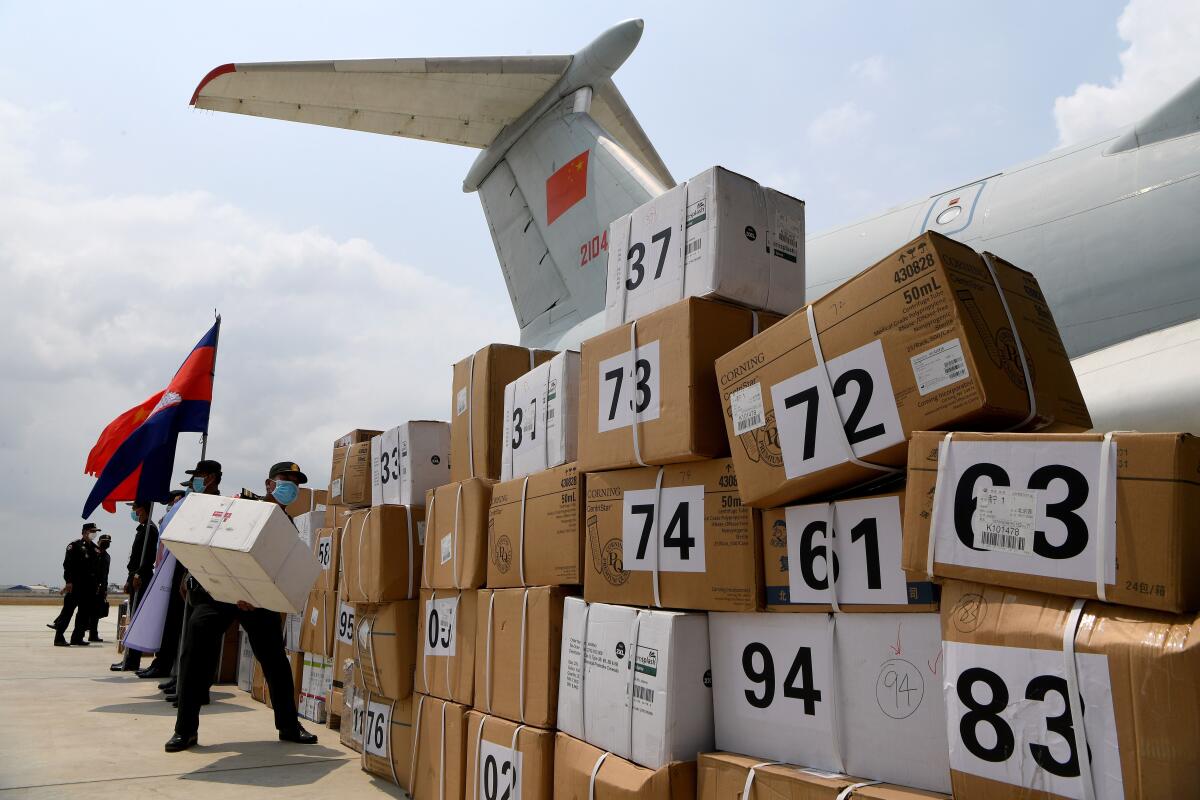
On one day last month, Chinese state media trumpeted more than a dozen reports of Beijing donating aid to battle the coronavirus: gloves to Italy, testing kits to Ethiopia, protective medical suits to South Korea.
The same day, March 20, the official New China News Agency carried a report headlined, “New research stations come into operation on Nansha Islands,” describing the opening of two civilian labs to study the marine environment in the South China Sea.
The announcement, using China’s name for what are more commonly known as the Spratly Islands, elided the bitter dispute surrounding the archipelago, where the Chinese military has created a series of artificial islands to house military outposts.
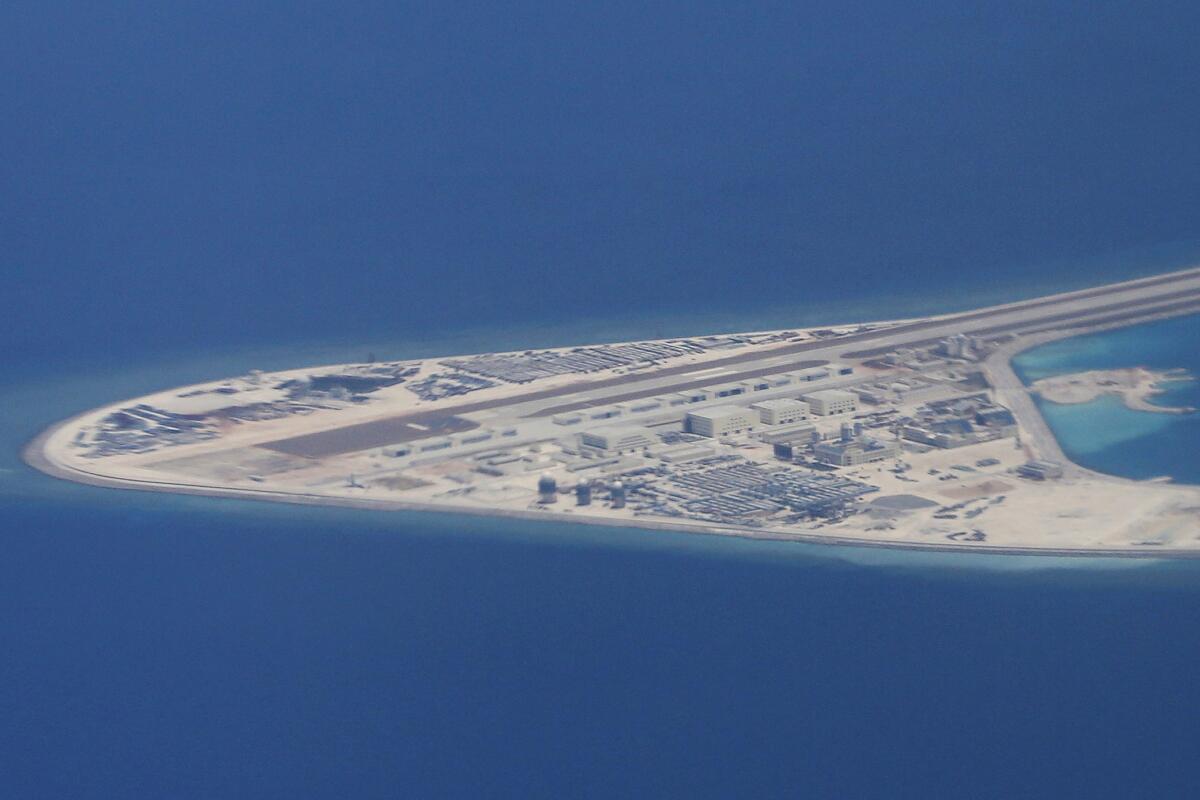
The two research stations are located on Fiery Cross Reef and Subi Reef — each claimed by the Philippines and Vietnam — where China has dredged land to build runways, missile emplacements, radar towers and barracks that could house thousands of troops.
Although the labs are described as civilian in nature, security analysts say China could use the research to step up exploration of deep-sea oil and gas, rare metals and other resources.
Last month, a Chinese transport plane landed on Fiery Cross Reef, the sort of routine supply mission that often goes unnoticed in what Poling called “China’s low-level, day-to-day consolidation of the South China Sea.”
The waterway, through which more than $3 trillion in goods transits every year, is one of the most contested regions of the world. Sitting atop large oil and gas reserves, it is the main sticking point in China’s relations with Southeast Asian countries, including half a dozen that hold competing island claims.
Beijing’s aggressive actions there are at odds with the softer image it has tried to project since the coronavirus outbreak, which emerged in central China late last year and raced around the world. China was criticized for initially underreporting the severity of the outbreak, but has since held itself up as an indispensable power in helping contain the virus’ global spread.
As China reports that COVID-19 cases are on the wane domestically, it has donated protective equipment to more than 120 countries, fired up factories to meet the global demand for ventilators and deployed medical experts to assist other nations. The Chinese leadership has rejected criticism that its assistance is politically motivated, saying that “it is never on its agenda to make aid a ploy to pursue influence.”
The U.S. has increased aid as well, contributing an additional $274 million in emergency health and humanitarian assistance to countries worldwide, including $18 million in Southeast Asia.
In this region, which is battling to get a new wave of infections under control, China’s humanitarian aid is welcome, Koh said. But governments also recognize that China’s maritime maneuvers have continued while rival claimants “have their hands full grappling with the coronavirus crisis,” he added.
“There’ll be inevitably an impact on trust and how these governments view Beijing’s intentions,” Koh said. “China will have to tread water very carefully if it doesn’t wish to see its diplomatic gains from this coronavirus outreach offset by what it’s doing in the South China Sea.”
Scenes from around the world as coronavirus upends everyday life and customs.
The tensions spilled into view last week after a Chinese military vessel rammed and sank a Vietnamese fishing boat off the disputed Paracel Islands, the second such incident in less than a year. Vietnam lodged a formal protest, and the Trump administration accused China of “exploiting the distraction or vulnerability of other states to expand its unlawful claims in the South China Sea.”
Beijing blamed the Vietnamese ship for fishing illegally in Chinese waters.
Individually, the claimants can do little to counter China’s military might. The U.S. has been unable to alter the status quo in the South China Sea even after a much touted “pivot to Asia” under the Obama administration and Trump’s trade war against Beijing.
The most important U.S. ally in the region, the Philippines, has failed to demand China adhere to a 2016 international ruling that denied Beijing’s sweeping claims over the South China Sea. Although the Philippines sided with Vietnam in the fishing boat incident, President Rodrigo Duterte has generally sought rapprochement with China and announced plans to cancel a major security pact with the U.S. that could unravel the decades-old alliance.
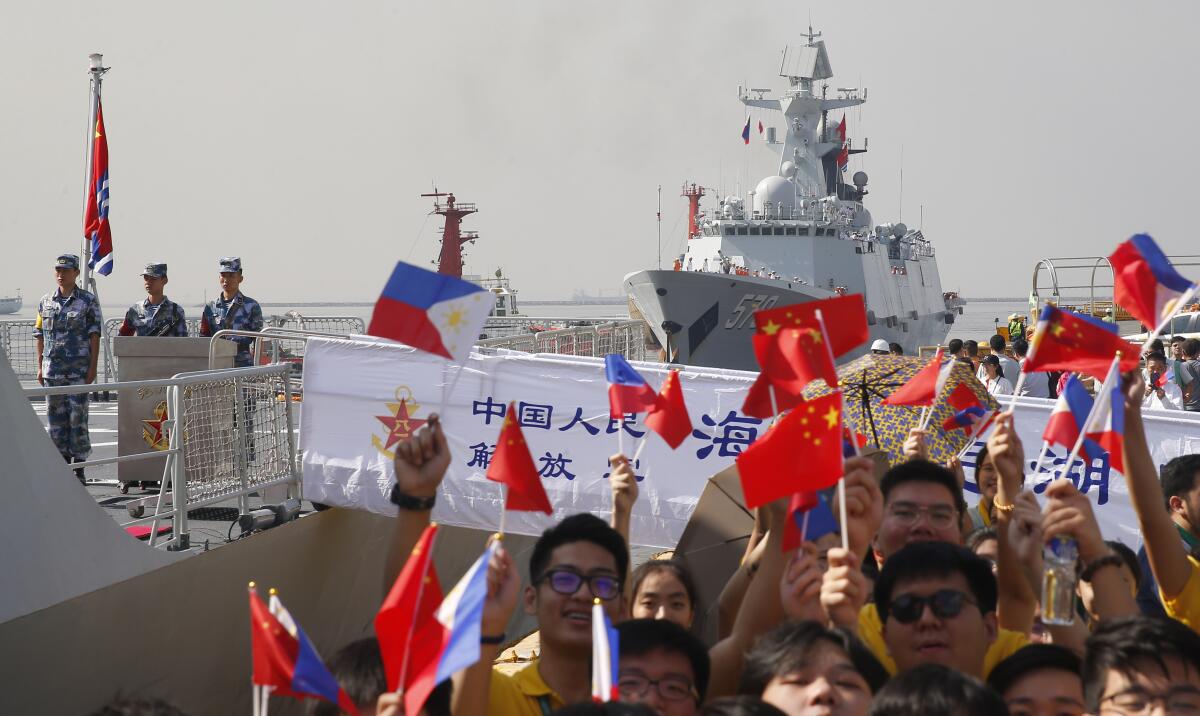
The U.S. military’s ability to project force in the South China Sea — usually by conducting port calls and sailing warships on “freedom of navigation” missions — has also been weakened by the pandemic.
The aircraft carrier Theodore Roosevelt had just concluded a visit to the Vietnamese port of Da Nang last month when sailors aboard were found to be infected with the virus. The ensuing fiasco — which culminated in the acting secretary of the Navy resigning after he criticized the ship’s commander, who was fired after speaking out about the risks to his crew — has grounded one of the key U.S. carriers in the region the Pentagon calls the Indo-Pacific.
Countries are beginning to worry about Washington’s capacity to fulfill its security commitments as it grapples with the health and economic costs of the pandemic, according to a commentary published this week by the Lowy Institute, an Australian think tank.
“Stricken warships, stalled deployments and Washington’s acute preoccupation with its own poorly handled humanitarian crisis will not reassure Indo-Pacific allies,” wrote the authors, Ashley Townshend and Jim Golby.
For now, the pandemic appears likely to widen the U.S.-China divide while convincing other Asian countries that both powers are unreliable.
The health crisis has strengthened hard-liners and driven China and the U.S., the world’s two biggest economies, closer to collision.
Malaysia, for example, has been stuck in a months-long confrontation with Chinese military vessels near two offshore blocks where Malaysia’s state-owned Petronas is drilling for oil and gas. A China Coast Guard ship drew to within 0.3 of a nautical mile of the Petronas rig in January before pulling away, highlighting what the Center for Strategic and International Studies said is China’s determination to bully any country that attempts to develop new energy sources in the area.
Last month, however, when China delivered a shipment of N95 masks, other protective gear and 200 ventilators to the Malaysian capital of Kuala Lumpur to help fight the coronavirus, New China News Agency reported that Malaysia’s foreign minister thanked Beijing by saying, “We really, truly know our friends in times of crisis.”
“Southeast Asian countries are getting used to dealing with China in this way — having some local skirmishes on territorial issues, but having the larger trade and diplomatic relationship going on at the same time,” said Zack Cooper, a research fellow at the American Enterprise Institute.
“These countries don’t have a lot of options on how to contest these claims,” he said. “The Chinese are confident that the status quo is stable in the South China Sea, and trending in their favor in the long term.”
More to Read
Sign up for Essential California
The most important California stories and recommendations in your inbox every morning.
You may occasionally receive promotional content from the Los Angeles Times.
